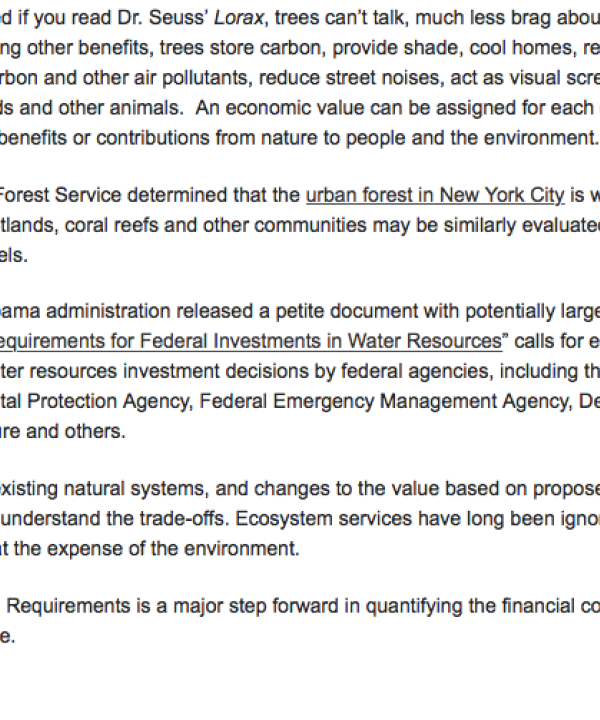August 14, 2013 | Water in the West | Insights
Numbers matter. When you interview for a job, you are routinely advised to quantify your achievements - for example, talk about how you brought in a 50% increase in sales or negotiated a $2 million deal for your company.

“I am the Lorax. I speak for the trees. I speak for the trees, for the trees have no tongues.” - Dr. Seuss
However, as you learned if you read Dr. Seuss’ Lorax, trees can’t talk, much less brag about their accomplishments. Among other benefits, trees store carbon, provide shade, cool homes, release oxygen, prevent soil erosion, remove carbon and other air pollutants, reduce street noises, act as visual screens, and provide habitat and food for birds and other animals. An economic value can be assigned for each of these ecosystem services, or the flow of benefits or contributions from nature to people and the environment.
For example, the U.S. Forest Service determined that the urban forest in New York City is worth $5.2 billion. Upland watersheds, wetlands, coral reefs and other communities may be similarly evaluated using best available science, tools and models.
Earlier this year, the Obama administration released a petite document with potentially large ramifications. The 16-page “Principles and Requirements for Federal Investments in Water Resources” calls for ecosystem services to be incorporated into water resources investment decisions by federal agencies, including the Army Corp of Engineers, Environmental Protection Agency, Federal Emergency Management Agency, Department of Interior, Department of Agriculture and others.
Clarifying the value of existing natural systems, and changes to the value based on proposed actions, will help decision-makers better understand the trade-offs. Ecosystem services have long been ignored in traditional benefit-cost analyses, at the expense of the environment.
The new Principles and Requirements is a major step forward in quantifying the financial contributions that nature makes to the bottom line.
By Janny Choy


![[Woods Logo]](/sites/default/files/logos/footer-logo-woods.png)
![[Bill Lane Center Logo]](/sites/default/files/logos/footer-logo-billlane.png)